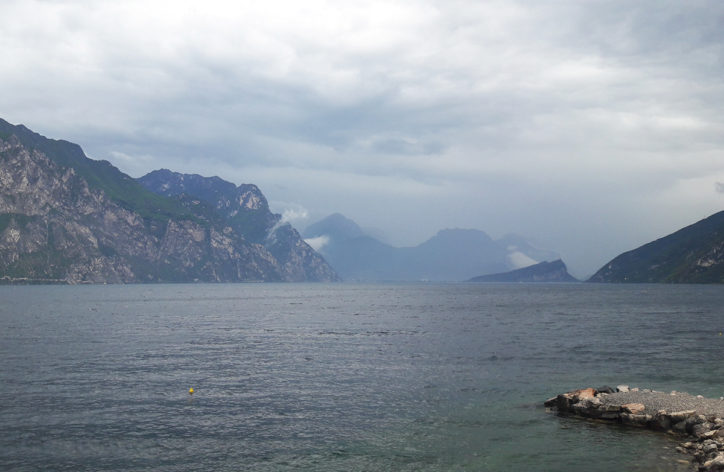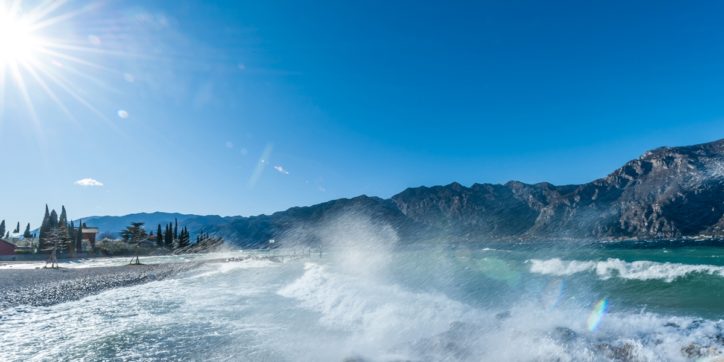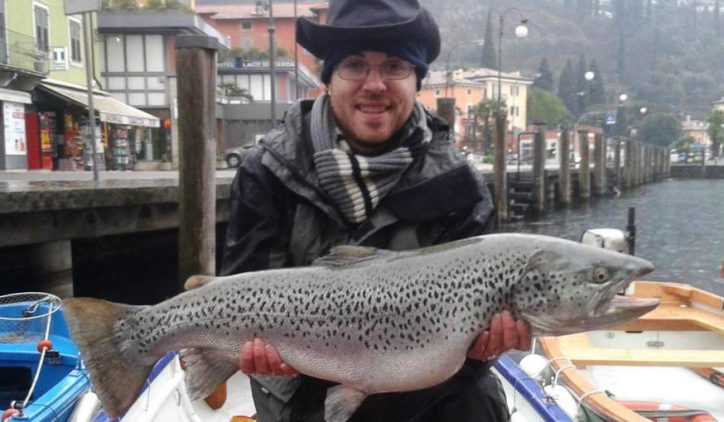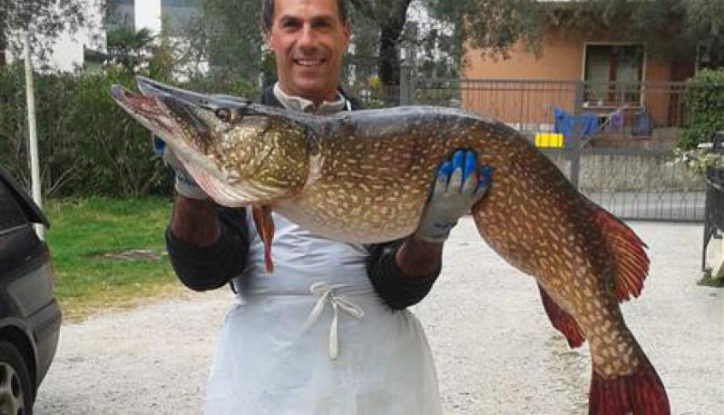The Garda or Lago di Garda (Italian name is lago di Garda, Benaco is used less often) is the largest lake in Italy. Its surface area is 375 sq. km. It is slightly smaller than the area of Lake Skadar (390 sq. km), which makes it the second largest lake in the countries adjacent to the Adriatic Sea.
However, the average depth of Lake Skadar is about 5 meters and its maximum depth is about 8 meters, and the average depth of Lago di Garda is 65 meters, and its maximum depth is 346 meters.

(Lake Garda. Photo by © adriaticnature)
The lake is located in the tectonic depression. The narrow and long northern part of the lake resembles a fjord that is framed by mountain ranges up to 2,000 meters high. The southern part is wider and lower. The lake is 52 km long, the extreme width is 16 km; the coastline is 158 km long.
The Garda extends from the north-west to the south-east. It is situated near the southern foot of the Alps and is protected by them from the northern cold winds. Thus, the coastal zone is characterized by the mild climate and lush vegetation of the Mediterranean type. Moreover, there are truly magnificent landscapes. All these things attract a huge number of guests during the tourist season.
Once again, the lake can be divided into two parts, namely: the North-West Basin with the maximum depth of 346 meters, and the South-East Basin with the maximum depth of about 80 meters. The division is also explained by the presence of an underwater fault, which is a natural barrier for full mixing of the waters of two parts of the Garda. There are shallows, one of which (the most famous one) is called “Secca di Garda”, on the border line of two suggested halves of the lake. The average depths are 3-5 meters. There 5 small islands on the lake.

(Lake Garda. Photo by © visitmalcesine.com)
The waters of Lake Garda flow at about 65 meters above sea level and have seasonal fluctuations of 1-1.5 meters, which are considered to be insignificant compared to other large Alpine lakes. The average surface water temperature is about 12°C, which drops to 8°C at the depth of 100 meters. The temperature fluctuates considerably throughout the year: the minimum temperature in December is about 6°C, the maximum temperature in August is 27°C.
25 small tributaries flow into the lake. The Sarca River is the most significant one. The lake feeds on underground sources as well. The Mincio River, which is a tributary of the Po River, and in its turn flows into the Adriatic Sea, is the only river that flows out of the lake. A rather weak outflow from the lake produces the effect of some kind of backwater. The lake is completely renewed in 26.8 years. The water in the Garda is transparent.

(Mouth of the Sarca River. Photo by pikabu.ru)
Two interesting natural phenomena can be observed in the lake. The first one is standing waves called seiches. They occur in closed or partially closed water bodies. Changes in atmospheric pressure, wind and seismic events are causes of their occurrence. In the Garda, seiches are up to 30 centimeters high on the average. They often occur, when the water surface is quiet, and last from a few minutes to several hours. The second phenomenon is the sudden occurrence of currents, which resemble rivers flowing on the surface of the lake and often have a different, lighter, shade of water color. They appear in various places and at different times of the year, have different speeds and directions. The difference in water temperature in the Garda is the reason for their occurrence.
Fans of sailing like the lake due to its winds. The Garda is a water body oriented from north to south towards the valley of the Po River. A lot of typical winds of Lago di Garda are the result of the difference in atmospheric pressures between the lower valley part of the lake and the upper alpine mountainous part. They cause the occurrence of air currents descending from the mountains down to the plain in the morning and rising up to the mountains at daytime. Many of them blow almost every day.

(Storm on the Garda Lake. Photo by © Angela Trawoeger. visitmalcesine.com)
According to reliable sources, there was only one case of onset of ice on the Garda surface in 1709.
In addition to the informative part concerning the lake, of course, adriaticnature tried to figure out its fish fauna and fishing on Lake Garda.
About 30 species inhabit the lake. Salmo carpio or Carpione del Garda (Italian) is a unique species.
Carpione, the endemic of Lago di Garda, has been known since the days of the ancient Romans, who extolled its taste. However, a lot of water has flowed down even from slowly changing waters of the Garda since that time.
Carpione is a fish inhabiting the depths from 100 to 200 meters, swimming up only during spawning, which occurs both in summer and in winter. Scientists have a dispute: either the spawning process is so prolonged, or two different forms of fish inhabit the lake.
The maximum length of carpione del Garda is about 70 centimeters, and the maximum weight is about 5 kilograms. Usually, the fish is up to 35-40 cm long and weighs up to 500 grams. Salmo carpio feeds mainly on planktonic crustaceans. But at the same time, the fish is more than interested in artificial lures. Modern Italian fishermen, living on the banks of the Garda, got the secrets of making these lures from their forefathers, grandfathers and fathers, who reached carpione.

(Carpione del Garda weighing 4.73 kg, 2018. Photo by © Mauro Fava. bresciasettegiorni.it)
Historically, carpio has been the fishing aim on the lake. In the 1960s, 16 to 40 tons of Salmo carpio was caught per year. In recent years, a ton of this fish is caught per year. Unfortunately, these statistics show that this rare fish is not cared enough. Carpione del Garda is currently listed in the IUCN Red List as a species that remain in critical condition (CR). However, some inconsistencies in the international legislation permit legal fishing for this endangered species. Considering the studies of ichthyologists and ecologists, the number of carpione del Garda in the lake has decreased by 80% over the past 10 years. And experiments with populating juveniles in other water bodies have failed.
However, in addition to overfishing, there are other factors of the trout population reducing. European whitefish, which settled in the lake long time ago, got accustomed really well and became a competitor for carpio as regards food.
Scientists raise alarm, and there is hope that the Salmo carpio population, carpione del Garda, can be saved and restored. Apparently, the ancient Romans treated this fish much more carefully than the contemporary ones, providing it with the opportunity to get acquainted with its distant descendants.
If you are determined to go fishing on Lake Garda, of course, following the catch and release principle is desirable, if you catch this wonderful fish.
In addition to carpione del Garda, other representatives of Lake Garda will keep company for those who like fishing with artificial lures.

(Brown trout weighing 9.1 kg from the Lake Garda. 2018. Photo by © Riccardo Andreis. ilgiornaledivicenza.it)
Brown trout (lake trout), which can weigh more than 10 kilograms, European whitefish, which, as it was already mentioned, settled in the lake, pike, perch, largemouth black bass, chub, and, perhaps, wels catfish and pike-perch can become trophies of fishermen who like fishing with a spinning rod. Nevertheless, the most numerous group of predators in the lake is the Agone shad, the sea fish of the Clupeidae family. This fish forms populations in some lakes, as in the case of Lago di Garda, and inhabits them constantly.
Fans of catching “peaceful” fish can search for common carp, crucian and Prussian carp, tench and other members of the Cyprinidae family, as well as European eel.
Lake Lago di Garda with its shores and waters managed to settle in three different administrative districts of Italy at the same time, including Lombardy (with the province of Brescia), Venice (with the province of Verona) and Trentino-Alto Adige (with the province of Trento). This makes the process of choosing the fishing site a little more complicated. According to the laws of Italy, each district and province has the right to regulate the principles of recreational fishing and grant licenses within its territories independently. Therefore, you should decide in advance what kind of fish you intend to catch – you will find salmon mainly in the northern part of the lake, which belongs to the province of Trento, the rest of the ichthyofauna representatives inhabit mainly the southern part – Brescia and Verona. Besides, the license for fishing on Lake Garda doesn’t mean you have the right to fish in nearby lakes or rivers of the provinces. Moreover, there are seasonal bans on catching certain species, and the permitted size of fish taken from the lake, which you should definitely get acquainted with before traveling to one of the most beautiful lakes in northern Italy.

(Northern pike weighing 21.6 kg from the Lake Garda. Photo by © Alberto Rania. ladige.it)
Lake Garda fish species:
– Salmo carpio – Carpione del Garda (Italian);
– Brown trout (Salmo trutta) – Trota europea, trota fario, trota lacustre (Italian);
– European whitefish (Coregonus lavaretus) – Lavarello, сoregone o lavarello (Italian);
– European eel (Anguilla anguilla) – Anguilla (Italian);
– Agone (Alosa agone) – Agone (Italian);
– Crucian carp (Carassius carassius) – Carassio (Italian);
– Prussian carp (Carassius gibelio) – Carpa di Prussia (итальянский);
– Common carp (Cyprinus carpio) – Carpa (Italian);
– Leucos aula – Triotto (Italian)
– Sarmarutilus rubilio – Rovella (Italian);
– Сommon rudd (Scardinius erythrophthalmus) – Scardola europea (Italian);
– European chub (Squalius cephalus) – Cavedano europeo (Italian);
– Amur bitterling (Rhodeus sericeus) – Rodeo arcobaleno (Italian);
– Common bleak (Alburnus alburnus) – Alburno (Italian)
– Barbel (Barbus barbus) – Barbo europeo (Italian);
– Tench (Tinca tinca) – Tinca (Italian);
– Grass carp (Ctenopharyngodon idella) – Carpa erbivora, Amur (Italian);
– Stone moroko (Pseudorasbora parva) – Pseudorasbora (Italian);
– Italian spined loach – Сobite comune, сobite italiano (Italian);
– Wels catfish (Silurus glanis) – Siluro d’Europa (Italian);
– Black bullhead (Ameiurus melas) – Pesce gatto nero (Italian);
– Northern pike (Esox lucius) – Luccio (Italian);
– Burbot (Lota lota) – Bottarice (Italian);
– Largemouth black bass (Micropterus salmoides) – Persico trota, Boccalone (Italian);
– Pumpkinseed (Lepomis gibbosus) – Persico sole, Gobbetto, Gobbo (Italian);
– European perch (Perca fluviatilis) – Persico reale, Pesce persico (Italian);
– Pike-perch (Sander lucioperca) – Lucioperca, Sandra (Italian);
– Ruffe (Gymnocephalus cernua) – Acerina (Italian);
– Freshwater blenny (Salaria fluviatilis) – Сagnetto (Italian);
– Eastern mosquitofish – Gambusia orientale (Italian).